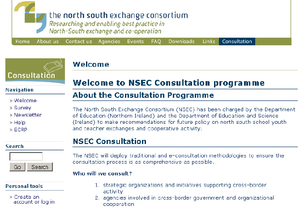Difference between revisions of "NSEC E-consultation Design"
m |
m |
||
| Line 1: | Line 1: | ||
| − | During the [[N-S Educational Exchange Process and Planning#Key Issues|series of meetings]] that constituted the [[N-S Educational Exchange Process and Planning#Planning Process|planning phase]] of the [http://www.nsec.info NSEC] trial, several possible e-consultation strategies were proposed that could be used to suit NSEC consultation needs, such as on-line surveys and the incorporation of forums into a website. | + | =====E-Consultation Strategies===== |
| + | During the [[N-S Educational Exchange Process and Planning#Key Issues|series of meetings]] that constituted the [[N-S Educational Exchange Process and Planning#Planning Process|planning phase]] of the [http://www.nsec.info NSEC] trial, several possible e-consultation strategies were proposed that could be used to suit [http://www.nsec.info NSEC] consultation needs, such as on-line surveys and the incorporation of forums into a [http://consultation.nsec.info/wiki/index.php/Welcome website]. | ||
| + | =====Traditional + Technological Elements Used===== | ||
The considered opinion of the both [http://www.nsec.info NSEC] and the e-consultation [http://www.e-consultation.org research team] was that conventional consultation techniques and e-consultation elements should be applied to the process. | The considered opinion of the both [http://www.nsec.info NSEC] and the e-consultation [http://www.e-consultation.org research team] was that conventional consultation techniques and e-consultation elements should be applied to the process. | ||
| + | =====Benefit from comparison===== | ||
From [http://www.nsec.info NSEC's] point of view it allowed all channels of communication to be exploited and from the research team’s perspective it afforded an opportunity to compare various methods, and to see how well technology fitted in with, and helped on, a public consultation. [[N-S Educational Exchange Process and Planning#Planning Process|Click here to see an overview of the econsultation design process]]. | From [http://www.nsec.info NSEC's] point of view it allowed all channels of communication to be exploited and from the research team’s perspective it afforded an opportunity to compare various methods, and to see how well technology fitted in with, and helped on, a public consultation. [[N-S Educational Exchange Process and Planning#Planning Process|Click here to see an overview of the econsultation design process]]. | ||
| Line 9: | Line 12: | ||
NSEC planned a meeting to launch their consultation in November 2005. At the launch they would present the research reports they had commissioned on N-S educational exchange to an audience of educationalists from a range of stakeholders across Ireland (often at senior policy levels). Their web site, with all the [http://www.nsec.info/downloads.htm research reports], would be revealed at the same time. | NSEC planned a meeting to launch their consultation in November 2005. At the launch they would present the research reports they had commissioned on N-S educational exchange to an audience of educationalists from a range of stakeholders across Ireland (often at senior policy levels). Their web site, with all the [http://www.nsec.info/downloads.htm research reports], would be revealed at the same time. | ||
| + | =====Launch Stages===== | ||
So the first stages of the e-consultation were to be launched at the same time. The first stages of the e-consultation were: | So the first stages of the e-consultation were to be launched at the same time. The first stages of the e-consultation were: | ||
# ''A short e-voting session during the presentations'', to get instant responses from the audience. | # ''A short e-voting session during the presentations'', to get instant responses from the audience. | ||
Revision as of 12:54, 26 April 2007
Contents
E-Consultation Strategies
During the series of meetings that constituted the planning phase of the NSEC trial, several possible e-consultation strategies were proposed that could be used to suit NSEC consultation needs, such as on-line surveys and the incorporation of forums into a website.
Traditional + Technological Elements Used
The considered opinion of the both NSEC and the e-consultation research team was that conventional consultation techniques and e-consultation elements should be applied to the process.
Benefit from comparison
From NSEC's point of view it allowed all channels of communication to be exploited and from the research team’s perspective it afforded an opportunity to compare various methods, and to see how well technology fitted in with, and helped on, a public consultation. Click here to see an overview of the econsultation design process.
E-consultation for the NSEC Launch Event
NSEC planned a meeting to launch their consultation in November 2005. At the launch they would present the research reports they had commissioned on N-S educational exchange to an audience of educationalists from a range of stakeholders across Ireland (often at senior policy levels). Their web site, with all the research reports, would be revealed at the same time.
Launch Stages
So the first stages of the e-consultation were to be launched at the same time. The first stages of the e-consultation were:
- A short e-voting session during the presentations, to get instant responses from the audience.
- The possibility to sign up to an e-newsletter, so that NSEC could e-mail people with news about educational exchange and also opportunities to participate in the consultation.
- A short on-line questionnaire. The research team designed a consultation web site for NSEC, including mailing list subscription software (PHP list), and questionnaire run on [www.phpsurveyor.org/index.php PHP Surveyor], and pages introducing the consultation and all the conventional and electronic ways in which people might participate (See thumbnail figure, right).
The research team also designed a set of questions for the launch meeting.
